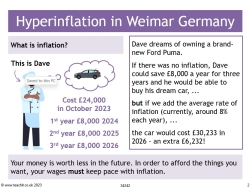Hyperinflation in Weimar Germany

A complete lesson on the causes of German hyperinflation during the Weimar Republic. It includes an example of inflation in the present day, a definition of hyperinflation and a student-friendly demonstration of why hyperinflation is a problem, as well as information sheets on the causes of hyperinflation in Germany in the 1920s.
After looking at an example of how money loses value over time, students take part in a treasure hunt to find the causes of the 1923 hyperinflation crisis displayed around the room. As part of this activity, they earn marks towards a get-out-of-homework pass, only to discover that the number of marks needed to purchase the pass has risen astronomically between the start of the activity and the end – a fun way to help them understand what happened in 1923 and why it caused so much consternation.
To summarise the information, they draw or complete a spider diagram showing:
- the debt from World War I
- the burden of reparations payments
- the occupation of the Ruhr by France and Belgium
- the policy of non-cooperation with the French and Belgians
- the printing of banknotes
as causes of the massive devaluation of the German mark.
Finally, they consider who the winners and the losers were in the German hyperinflation crisis.
One of the information sheets from this resource:
Massive burden of reparations
- The Treaty of Versailles (Clause 232) stated that Germany had to pay reparations (a type of fine), which were set at £6.6 billion in 1921.
- The German government claimed it could not afford such an amount and many outside Germany agreed.
- The Allies said Germany could pay reparations in gold and American dollars and also in goods – coal, steel and timber – but not in German currency.
